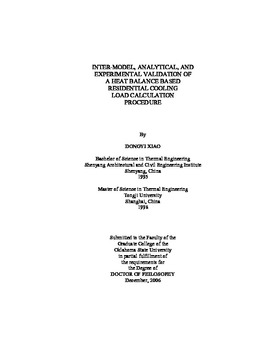| dc.contributor.advisor | Spitler, Jeffrey D. | |
| dc.contributor.author | Xiao, Dongyi | |
| dc.date.accessioned | 2013-12-10T18:05:23Z | |
| dc.date.available | 2013-12-10T18:05:23Z | |
| dc.date.issued | 2006-12 | |
| dc.identifier.uri | https://hdl.handle.net/11244/7823 | |
| dc.description.abstract | Scope and Method of Study: A systematic validation of the ASHRAE heat balance based residential cooling load calculation procedure (RHB) has been performed with inter-model comparison, analytical verification and experimental validation. The inter-model validation was performed using ESP-r as the reference model. The testing process was automated through parametric generation and simulation of large sets of test cases for both RHB and ESP-r. The house prototypes covered include a simple Shoebox prototype and a real 4-bedroom house prototype. An analytical verification test suite for building fabric models of whole building energy simulation programs has been developed. The test suite consists of a series of sixteen tests covering convection, conduction, solar irradiation, long-wave radiation, infiltration and ground-coupled floors. Using the test suite, a total of twelve analytical tests have been done with the RHB procedure. The experimental validation has been conducted using experimental data collected from a Cardinal Project house located in Fort Wayne, Indiana. During the diagnostic process of the experimental validation, comparisons have also been made between ESP-r simulation results and experimental data. | |
| dc.description.abstract | Findings and Conclusions: It is concluded RHB is acceptable as a design tool on a typical North American house. Analytical tests confirmed the underlying mechanisms for modeling basic heat transfer phenomena in building fabric. The inter-model comparison showed that the differences found between RHB and ESP-r can be traced to the differences in sub-models used by RHB and ESP-r. It also showed that the RHB-designed systems can meet the design criteria and that the RHB temperature swing option is helpful in reducing system over-sizing. The experimental validation demonstrated that the systems designed with the method will have adequate size to meet the room temperatures specified in the design, whether or not swing is utilized. However, actual system operation may cause deviations in the room temperatures, particularly in the slave rooms. For better prediction of these deviations, simulation or a better approximation for interzone airflows and heat transfers would be needed. The RHB procedure may be said to give cooling loads that are as accurate as the inputs and real-life uncertainties inputs will be more significant than errors that caused by the method. | |
| dc.format | application/pdf | |
| dc.language | en_US | |
| dc.rights | Copyright is held by the author who has granted the Oklahoma State University Library the non-exclusive right to share this material in its institutional repository. Contact Digital Library Services at lib-dls@okstate.edu or 405-744-9161 for the permission policy on the use, reproduction or distribution of this material. | |
| dc.title | Inter-model, analytical, and experimental validation of a heat balance based residential cooling load calculation procedure | |
| dc.contributor.committeeMember | Fisher, Daniel E. | |
| dc.contributor.committeeMember | Delahoussaye, Ronald D. | |
| dc.contributor.committeeMember | Mansy, Khaled | |
| osu.filename | Xiao_okstate_0664D_2013.pdf | |
| osu.accesstype | Open Access | |
| dc.type.genre | Dissertation | |
| dc.type.material | Text | |
| thesis.degree.discipline | Mechanical Engineering | |
| thesis.degree.grantor | Oklahoma State University | |
